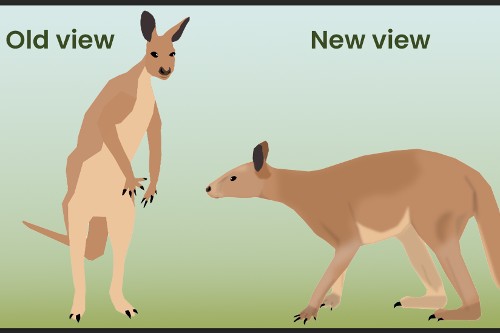
New interpretation of Protemnodon shown next to a person and the largest of today's kangaroos, the red kangaroo (Osphranter rufus).Drawings by Billie Jones.
A type of extinct kangaroo that lived during the Pleistocene around two and a half million to ten thousand years ago, known as the 'giant wallaby', was a poor hopper, a study by scientists at the University of Bristol have found.
Several large key species of kangaroo, all bigger than modern kangaroos and known as Protemnodon, were previously assumed to have hopped, despite their size. However findings, published today in the Journal of Mammalian Evolution, show that they were mainly quadrupedal and likely used four legs to move around most of the time.
Lead author Billie Jones, a former Masters student in the Bristol Paleobiology programme explained: "There had been some speculation in a graduate thesis from the University of Uppsala that it might have been more quadrupedal in its habits compared to living kangaroos.
"This new paper draws on a couple of previous quantitative studies that looked at the anatomy of the humerus (upper arm bone) in a diversity of mammals, and concluded that Protemnodon habitually put more weight on its forelimbs than kangaroos today."
Previous research has shown that the ankle bones of Protemnodon were unsuited to withstand the stresses of hopping.
The team showed that the limb proportions of Protemnodon were quite unlike that of any living kangaroos, especially the short feet, backing up the proposal that it was mainly quadrupedal, rather than a dedicated hopper like living large kangaroos.
This new paper is a quantitative study of limb proportions, plus a more qualitative discussion of some other aspects of the anatomy, in an attempt to confirm the locomotion of this extinct animal.
This provides further evidence that the taxonomic diversity of large kangaroos in the Pleistocene of Australia was matched by a locomotor diversity. Supervisor Professor Christine Janis of Bristol's School of Earth Sciences had already shown that extinct sthenurines - a separate subfamily of kangaroos - were bipedal striders rather than hoppers. This locomotor diversity suggests a greater variety of habitats in the Australian Pleistocene than previously considered, with the continent not as arid as it is currently.
Professor Janis added: "A study of the limb bones, and the bone proportions to each other, show that the so-called extinct 'giant wallaby', Protemnodon, was likely a poor hopper at best, and probably moved mostly quadrupedally, perhaps bounding on all fours like tree-kangaroos do on the ground."
Billie Jones won both the David Dineley Prize and the Curry Prize for this thesis.
Paper:
'Hop, Walk or Bound? Limb Proportions in Kangaroos and the Probable Locomotion of the extinct genus Protemnodon' by Billie Jones and Christine Marie Janis in Journal of Mammalian Evolution.






